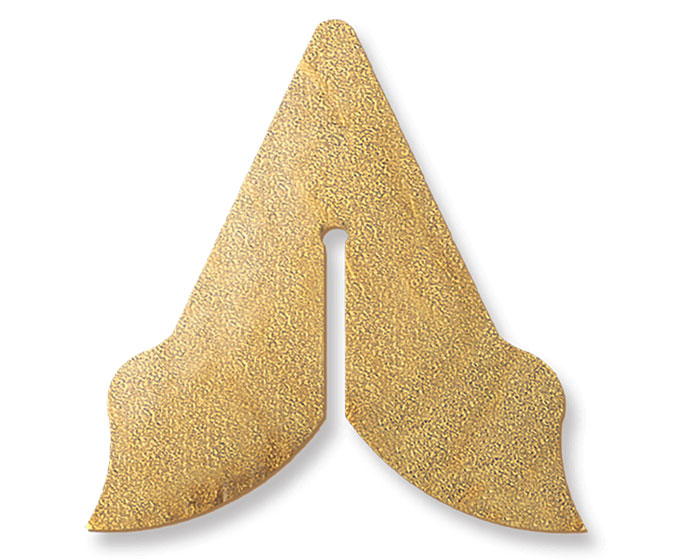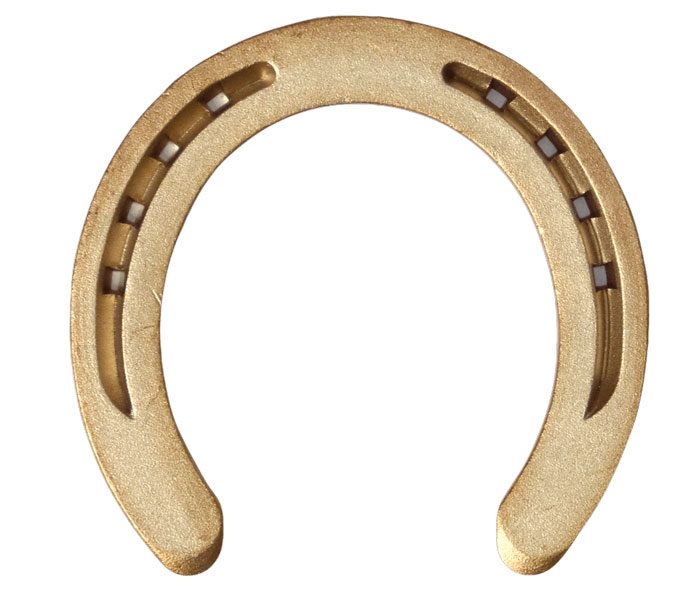There are inexpensive, over-the-counter treatments for fighting common hoof diseases that work well.
Horse owners, of course, should still regularly clean the horse’s feet by picking and brushing them out with a good hoof pick before the application of these products. However, the success of these topical treatments relies on the horse owner following the product directions as well as their farriers’ directions.
There’s another option, though, that improves treatment reliability — Kawell USA’s copper-alloy horseshoes, says Esco Buff, PhD, APF-I, CF, of Clearwater, Fla.
Benefits of Copper Alloy
Copper-alloy horseshoes act against hoof diseases like thrush, seedy hoof and onychomycosis (commonly known as white line disease) as well as other hoof- related diseases.
Kawell’s copper-alloy horseshoes are approved by the Environmental Protection Agency (EPA) for their antimicrobial properties. They are proven to kill 99.9% of bacteria within just 2 hours of exposure as copper is a natural antifungal and antibacterial.
“It remains effective even after repeated wet/dry abrasion and recontamination. The natural process of copper tarnishing does not impair its efficacy either,” says Buff during the Kawell USA Hoof-Care Product Knowledge Clinic presented at the 2024 International Hoof-Care Summit in Cincinnati, Ohio. “Copper has antimicrobial properties, as all copper does, but it’s a matter of degrees. If you’re using certain building materials, like on old homes, for example, they would put copper cupolas and copper ridge plates on to keep the moss from growing, help kill the bacteria, etc.”
Takeaways
- Kawell’s copper-alloy horseshoes have been tested and approved by the EPA to continuously reduce 99.9% of bacteria within 2 hours of exposure.
- Copper-alloy shoes are a cost-effective solution to treat hoof diseases when horse owners are unreliable in the application of topical treatments.
- Copper-alloy shoes have the same wear as traditional steel shoes.
If you’re using copper, such as a copper plate like some farriers do underneath a shoe, it has some degree of antimicrobial benefits. But what studies find is the level of the antimicrobial properties is so minuscule that it’s not taking care of any of the bad bacteria that need to be killed.
“That’s where you need an EPA-approved copper alloy,” Buff says. “There are six categories based on their percentages, and it allows each category to make different claims. Copper has antimicrobial properties, as we know, and the microorganisms do have to come in contact with the copper for it to be killed. You put that shoe on the hoof, and it’ll kill anything that gets underneath the shoe — even the seedy hoof areas. If you put a frog plate in now, you can also effectively treat thrush, canker and stuff on the frog itself.”
Copper can kill germs in a few ways — by disrupting the bacterial cell membranes or by damaging the cell membranes and destroying the DNA or RNA of the microbe. It generates oxidative stress on bacterial cells, and it essentially creates hydrogen peroxide that can kill the cell by interfering with the proteins that operate important functions that keep bacteria cells alive.
Treat Hoof Disease Effortlessly
Thrush is one of the most commonly occurring hoof diseases, especially during certain times of the year when there’s excessive moisture on the ground. There are typically several questions that come up surrounding the treatment of thrush, such as the costs, effectiveness, whether the horse owner follows through with the treatment plan or the cause of the thrush in the first place.
When treating thrush on a seedy hoof, or what some people call seedy toe, these questions need to be resolved to have the highest success. It’s not about just slapping something on the hoof once in a while and hoping for the best.

The Environmental Protection Agency approves the Kawell USA copper- alloy-frog insert to kill 99.9% of bacteria within 2 hours of exposure. Kawell
“I get tired of coming out to shoe a horse and the animal’s out in a mucky, nasty pasture,” Buff says. “People typically can’t change their pasture situation, and the owner says, ‘I swear, I’ll put this treatment on every day.’ That usually lasts 2 days at best. Then, the next time I see the treatment done is before we show up for the next shoeing. They put the treatment on the foot again to say that they’ve been doing it. Then they wonder why the seedy hoof is not going away.
“These are all questions we sort of do instantaneously in our head,” he continues, “but how do we break down the process of resolving a lot of these issues?”
Most treatments require the farrier to first trim the frog and hoof correctly, as well as remove any infected areas and debris. At this point, treatment options can then be evaluated.
However, there are many questions to consider when looking into these different treatment options. Is it safe or caustic? Will the topical medication be applied according to the directions? Will the infected area be cleaned regularly according to the directions? Will the treatment be simple for the horse owner to do on their own, or will it be too complex? Will the horse’s environment be altered if recommended? What will be the total treatment cost?
There are inexpensive treatments for fighting hoof diseases that work well. As previously mentioned, horse owners should ensure the horse’s feet are cleaned out regularly before the application of most of these topical products.
“It remains effective even after repeated wet-dry abrasion and recontamination…”
Many professional farriers recommend well-established commercial preparations for treatments that are known to be safe and effective against hoof diseases. However, studies show home remedy recommendations, no matter how well intended, are more caustic and can be dangerous, leading to permanent damage to the hoof structure. It’s more common to run into these types of issues when people are using bleach or other similar items on their horses’ feet. The success of any treatment relies on the horse owner following cleaning and product directions, as well as the farriers’ directions. Prices can range from $14-42 for a bottle of these over-the-counter topical treatments. However, the success of the treatment still relies on the horse owner following the directions on the product label.
“What if we could apply a product once and have it working continuously without the horse owner having to do anything more with another product?” Buff asks. “The product would cost about $25-32 if used once by the farrier. The next cycle, $12.50-16 if used twice, and $8-10 if used three times during a farrier cycle, so it’s more cost-effective. It’s just easier to say to the horse owner for a few bucks more, we’ll put this therapeutic shoe on and you don’t need to do anything else. Send the horse back out to that mucky pasture because it’s going to start killing the bacteria all on its own.”
When considering using copper- alloy horseshoes, it also begs the question, are copper nails also required, or recommended, when using copper- alloy shoes?
“I used copper nails in an aluminum shoe because I noticed less pitting on the underside — that’s the copper leaching out of the nail because it’s clean in that area,” Buff says. “However, when I'm using steel nails, there’s so much pitting. When I went to the copper nails, some will be good and there will be a little pitting on some when the copper wears out, for example. But I find the nail holes are better when I use the copper nail on an aluminum shoe.”
Since copper is a softer material, how many resets can be expected with these types of shoes?
“Copper is soft; however, when it is alloyed with other materials, that gives it its strength, durability and shock absorption abilities,” he says. “I’m getting the same wear as I would out of a regular steel shoe. If I was getting a new shoe and two resets normally out of a shoe, I’m getting the same with the copper alloy on that same horse. There’s no difference between the wear of steel vs. the copper alloy.”









Post a comment
Report Abusive Comment